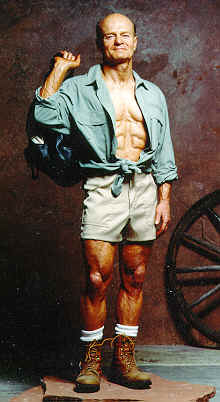Almost everyone past 50 who’s in phenomenal shape, and who got there later, relies heavily on strength training (pun intended).
I remember Muscle & Fitness writer Clarence Bass (below) from my ’80s World Gym days. He was in his 40s then, and looked exactly the same (I don’t think he’s ever had hair).
Bass stays on top of the research, so I trust his findings. He cites several studies that link increased body fat almost solely to decreased activity, not age. A simple and obvious conclusion with huge consequences—when your activity level decreases, so does your muscle mass. It’s those shrinking muscles that slow your metabolism.
That bears repeating. Age does not slow your metabolism, reduced muscle mass does.
How so?
Muscle not only weighs more than fat, it burns more than fat. When you gain muscle, your resting metabolic rate rises. The numbers vary from study to study, but there’s no doubt about it.
This theory goes far to explain why both crash diets and extreme aerobics ultimately fail. No muscle, no metabolism.
Muscles Grow At Any Age
Although their mass may decrease, your muscles remain metabolically viable. Mass can be regained at any age.

According to Bass, a Tufts University Study found that
The muscles of elderly people are just as responsive to weight training as those of younger people.
Tufts put a group of 87- to 96-year-old female nursing home residents on an 8-week strength training program. The gals tripled their strength and increased their muscle size by ten percent!
Bass believes there’s no biological reason to get fatter as you grow older. With good reason. Today, at age 70, he has a better body than most guys in their 20s. He began taking bodybuilding seriously in his 40s (although he had done Olympic weight lifting prior).
Wendy Ida (above) also began training in her 40s, after gaining 50 pounds with the birth of her second child. Last year she won 1st Place in the NPC National Figure Championships, at age 57.
Can You Be Your Fittest After Fifty?
Absolutely, as these photos attest. Keep in mind, however, that Clarence Bass and Wendy Ida went beyond the norm and became fitness professionals. If you’re a former Olympic athlete, do you really want to put in that kind of work again (bless Dara Torres)?
However, if you’re a regular person, and you’re a fitness late bloomer, go for it.
Then ask yourself, how does becoming my fittest enhance my Later Bloomer lifestyle? How do I want to use my fitness? What will it help me accomplish?
Walking 30 minutes, 3 times per week, might work for some folks. But clearly, for the majority, the real secret to losing weight and getting fit is gaining muscle.
